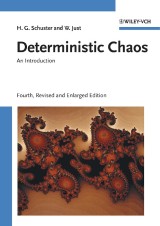Details

Deterministic Chaos
An Introduction4th Revised and Enlarged Edition
|
129,99 € |
|
| Verlag: | Wiley-VCH |
| Format: | |
| Veröffentl.: | 06.03.2006 |
| ISBN/EAN: | 9783527606412 |
| Sprache: | englisch |
| Anzahl Seiten: | 312 |
DRM-geschütztes eBook, Sie benötigen z.B. Adobe Digital Editions und eine Adobe ID zum Lesen.
Beschreibungen
A new edition of this well-established monograph, this volume provides a comprehensive overview over the still fascinating field of chaos research. The authors include recent developments such as systems with restricted degrees of freedom but put also a strong emphasis on the mathematical foundations. Partly illustrated in color, this fourth edition features new sections from applied nonlinear science, like control of chaos, synchronisation of nonlinear systems, and turbulence, as well as recent theoretical concepts like strange nonchaotic attractors, on-off intermittency and spatio-temporal chaotic motion.
Preface. <p>Color Plates.</p> <p>1 Introduction.</p> <p>2 Experiments and Simple Models.</p> <p>2.1 Experimental Detection of Deterministic Chaos.</p> <p>2.2 The Periodically Kicked Rotator.</p> <p>3 Piecewise Linear Maps and Deterministic Chaos.</p> <p>3.1 The Bernoulli Shift.</p> <p>3.2 Characterization of Chaotic Motion.</p> <p>3.3 Deterministic Diffusion.</p> <p>4 Universal Behavior of Quadratic Maps.</p> <p>4.1 Parameter Dependence of the Iterates.</p> <p>4.2 Pitchfork Bifurcation and the Doubling Transformation.</p> <p>4.3 Self-Similarity, Universal Power Spectrum, and the Influence of External Noise.</p> <p>4.4 Behavior of the Logistic Map for <I>r<sub>∞</sub>≤ r</I>.</p> <p>4.5 Parallels between Period Doubling and Phase Transitions.</p> <p>4.6 Experimental Support for the Bifurcation Route.</p> <p>5 The Intermittency Route to Chaos.</p> <p>5.1 Mechanisms for Intermittency.</p> <p>5.2 Renormalization-Group Treatment of Intermittency.</p> <p>5.3 Intermittency and 1/f-Noise.</p> <p>5.4 Experimental Observation of the Intermittency Route.</p> <p>6 Strange Attractors in Dissipative Dynamical Systems.</p> <p>6.1 Introduction and Definition of Strange Attractors.</p> <p>6.2 The Kolmogorov Entropy.</p> <p>6.3 Characterization of the Attractor by a Measured Signal.</p> <p>6.4 Pictures of Strange Attractors and Fractal Boundaries.</p> <p>7 The Transition from Quasiperiodicity to Chaos.</p> <p>7.1 Strange Attractors and the Onset of Turbulence.</p> <p>7.2 Universal Properties of the Transition from Quasiperiodicity to Chaos.</p> <p>7.3 Experiments and Circle Maps.</p> <p>7.4 Routes to Chaos.</p> <p>8 Regular and Irregular Motion in Conservative Systems.</p> <p>8.1 Coexistence of Regular and Irregular Motion.</p> <p>8.2 Strongly Irregular Motion and Ergodicity.</p> <p>9 Chaos in Quantum Systems?</p> <p>9.1 The Quantum Cat Map.</p> <p>9.2 A Quantum Particle in a Stadium.</p> <p>9.3 The Kicked Quantum Rotator.</p> <p>10 Controlling Chaos.</p> <p>10.1 Stabilization of Unstable Orbits.</p> <p>10.2 The OGY Method.</p> <p>10.3 Time-Delayed Feedback Control.</p> <p>10.4 Parametric Resonance from Unstable Periodic Orbits.</p> <p>11 Synchronization of Chaotic Systems.</p> <p>11.1 Identical Systems with Symmetric Coupling.</p> <p>11.2 Master–Slave Configurations.</p> <p>11.3 Generalized Synchronization.</p> <p>11.4 Phase Synchronization of Chaotic Systems.</p> <p>12 Spatiotemporal Chaos.</p> <p>12.1 Models for Space–Time Chaos.</p> <p>12.2 Characterization of Space–Time Chaos.</p> <p>12.3 Nonlinear Nonequilibrium Space–Time Dynamics.</p> <p>Outlook.</p> <p><b>Appendix.</b></p> <p>A Derivation of the Lorenz Model.</p> <p>B Stability Analysis and the Onset of Convection and Turbulence in the Lorenz Model.</p> <p>C The Schwarzian Derivative.</p> <p>D Renormalization of the One-Dimensional Ising Model.</p> <p>E Decimation and Path Integrals for External Noise.</p> <p>F Shannon’s Measure of Information.</p> <p>F.1 Information Capacity of a Store.</p> <p>F.2 Information Gain.</p> <p>G Period Doubling for the Conservative H´enon Map.</p> <p>H Unstable Periodic Orbits.</p> <p>Remarks and References.</p> <p>Index.</p>
"This text sets a standard which other authors and publishers in physics should strive to meet." (<i>Physics Bulletin</i>) <p>"This is the revised and updated 3rd edition of this highly regarded textbook. A new chapter on controlling chaos has been added. Translations into Japanese, Chinese, German, Russian and Polish demonstrate the international interest in this book."</p> <p><b>From reviews of former editions:</b></p> <p>"In this book, Schuster gives a very useful summary of the main ideas of the subject as it now stands. Although a physist by training and style, he organizes his treatment by the logic of the mathematics, which is based on the concept of a dynamical system."</p> <p>"Students about to begin research into chaos, and practising scientists new to the subject, will find this book well worth reading." (<i>Nature</i>)</p>
<b>Heinz Georg Schuster</b> is Professor of Theoretical Physics at the University of Kiel in Germany. In 1971 he attained his doctorate and in 1976 he was appointed Professor at the University of Frankfurt am Main in Germany. He was a visiting professor at the Weizmann-Institute of Science in Israel and at the California Institute of Technology in Pasadena, USA. <p><b>Wolfram Just</b> is Lecturer for Applied Mathematics at Queen Mary/University of London. He held positions at different institutions, for instance Kyushu University Fukuoka/Japan, MPIPKS Dresden/Germany, and Chemnitz University of Technology/Germany. His current research interests are nonlinear dynamics of systems with many degrees of freedom and nonequilibrium statistical physics.</p>
The new edition of this well-established monograph provides a comprehensive overview over the still fascinating and challenging field of chaos research. The authors present recent developments such as synchronisation and systems with many degrees of freedom but put also a strong emphasis on the comprehensible presentation of mathematical foundations. Illustrated in color, this fourth edition features sections on chaos control, unstable periodic orbits, the synchronization of chaotic systems, and spatiotemporal chaos. Students about to begin research as well as practising scientists will find this book well worth reading.<br />

















